Fishing Hook Size Chart (For Freshwater And Saltwater)
UPDATED 03 NOVEMBER 2023
by Robert Ceran
Are you confused by fishing hook sizes, and which one you should use for your next fishing trip?
Well, in that case, you’re not alone. Even experienced anglers sometimes have difficulty choosing the right hook size.
This problem is made worse by the perplexing terminology use by hook manufacturers for different hook types and sizes.
In this guide, I’ll cover everything you need to know about hook sizes, in order to help you to choose the right hooks for your purposes.
Read on below to get the full scoop.
Fishing hook size chart (in inches and centimeters)
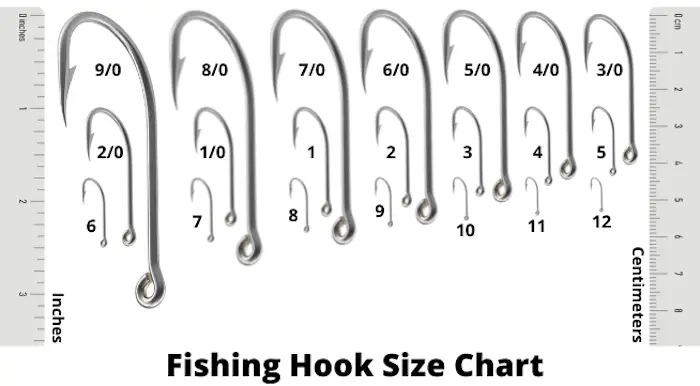
The image above shows a hook size chart ranging from size #12 to 9/0. If you’re viewing the image in full size, the hooks are drawn to scale, and are therefore 1-to-1 representations of the actual sizes of the hooks.
However, if you’re viewing this on a mobile device, the image size may be reduced by your browser, so you can’t take it as a direct representation of hook size (which is why I recommend viewing it on a desktop device to get a more accurate view).
The ruler on the left-hand side of the image shows size in inches, while the ruler on the right-hand side of the image shows centimeters and millimeters.
Also, keep in mind that hook size is not an absolute measurement, and can vary between manufacturers. For example, a Mustad 3/0 is not identical to an Eagle Claw 3/0, Gamakatsu 3/0, or Owner 3/0, which are all slightly different from each other.
So in general it’s best to handle hook sizes as rough approximations, in order to guide you when buying hooks, and then make adjustments while you’re fishing.
However, if you stick to the same brand of fishing hooks, their relative sizing will be 100% consistent, and this means you can have a very good idea of the actual size to expect (even if you buy them online).
Now let’s take a look at the best hook sizes to use for different fish species.
Fishing hook size chart for freshwater fish
| Fish species | Recommended hook size | Recommended hook types |
|---|---|---|
| Largemouth bass | 1/0 to 5/0 | Jig head, J-hook, worm hook, weighted hook |
| Smallmouth bass | #2 to 3/0 | Jig head, J-hook, worm hook, weighted hook |
| Catfish | 1/0 to 6/0 | J-hook, bait holder hook, circle hook |
| Trout | #16 to #3 | J-hook, bait holder hook, octopus hook, jig head |
| Steelhead | #8 to 1/0 | J-hook, bait holder hook, jig head |
| Salmon | 1/0 to 6/0 | J-hook, bait holder hook, jig head |
| Walleye | #3 to 2/0 | Jig head, J-hook, bait holder hook |
| Yellow perch | #12 to #4 | Jig head, J-hook, bait holder hook, Aberdeen hook |
| Crappie | #12 to #4 | Jig head, J-hook, bait holder hook, Aberdeen hook |
| Bluegill | #16 to #6 | Jig head, J-hook, bait holder hook, Aberdeen hook |
| Striped bass | 1/0 to 8/0 | J-hook, jig head, worm hook |
| White bass | #4 to #1 | J-hook, jig head, worm hook |
| Peacock bass | #3 to 3/0 | J-hook, jig head, worm hook |
| Northern Pike | 1/0 to 6/0 | Treble hook, J-hook, jig head |
| Muskellunge (Muskie) | 2/0 to 8/0 | Treble hook, J-hook, jig head |
| Carp | #2 to 5/0 | J-hook, circle hook, bait holder hook |
| Tilapia | #10 to #4 | J-hook, bait holder hook, Aberdeen hook |
| Sturgeon | 5/0 to 9/0 | J-hook, circle hook, bait holder hook |
| Burbot | #3 to 3/0 | J-hook, bait holder hook, Aberdeen hook |
| Alligator gar | 6/0 to 9/0 | J-hook, circle hook, bait holder hook |
| Longnose gar | 1/0 to 4/0 | Jig head, J-hook, circle hook |
| Sucker | #12 to #6 | J-hook, bait holder hook, Aberdeen hook |
| Shad | #10 to #4 | J-hook, bait holder hook, Aberdeen hook |
| Whitefish | #10 to #4 | Jig head, J-hook, octopus hook |
| Herring | #10 to #4 | J-hook, bait holder hook, Aberdeen hook |
The table above shows the recommended hook sizes to use for the most important species of freshwater fish.
Fishing hook size chart for saltwater fish
| Fish species | Recommended hook size | Recommended hook types |
|---|---|---|
| Redfish | #2 to 10/0 | J-hook, jig head, worm hook, weighted hook |
| Black Drum | 1/0 to 10/0 | J-hook, jig head, weighted hook |
| Large Snapper | 4/0 to 9/0 | Jig head, J-hook, bait holder hook |
| Small to medium Snapper | #5 to #1, 1/0 to 3/0 | Jig head, J-hook, bait holder hook |
| Grouper | 4/0 to 9/0 | Jig head, J-hook, bait holder hook |
| Spotted Sea Trout | 1/0 to 3/0 | J-hook, jig head, worm hook |
| Snook | 2/0 to 7/0 | J-hook, jig head, worm hook |
| Barracuda | 2/0 to 8/0 | J-hook, jig head, bait holder hook |
| Bluefish | 1/0 to 4/0 | J-hook, jig head, weighted hook |
| Jack Crevalle | 1/0 to 5/0 | J-hook, Jig head, weighted hook |
| Giant Trevally | 5/0 to 9/0 | J-hook, circle hook, weighted hook |
| Black Seabass | #4 to #1, 1/0 | J-hook, bait holder hook, jig head |
| Sheepshead | #5 to #1 | J-hook, bait holder hook, Aberdeen hook |
| Mahi-Mahi (Dorado) | 1/0 to 6/0 | J-hook, jig head, bait holder hook |
| Bluefin Tuna | 5/0 to 10/0 | J-hook, jig head, bait holder hook |
| Yellowfin Tuna | 2/0 to 6/0 | J-hook, jig head, bait holder hook |
| Sailfish | 3/0 to 8/0 | J-hook, bait holder hook |
| Marlin | 7/0 to 12/0 | J-hook, bait holder hook |
| Swordfish | 7/0 to 12/0 | J-hook, bait holder hook, circle hook |
| Tarpon | 3/0 to 8/0 | J-hook, bait holder hook, jig head |
| Pompano | #5 to #1, 1/0 to 2/0 | J-hook, bait holder hook, jig head |
| Cobia | 1/0 to 4/0 | J-hook, bait holder hook, jig head |
| Shark | 5/0 to 12/0 | J-hook, circle hook |
| Barramundi | 1/0 to 3/0 | J-hook, bait holder hook, jig head |
| Wahoo | 4/0 to 8/0 | J-hook, bait holder hook, circle hook |
| Kingfish | 4/0 to 7/0 | J-hook, bait holder hook, circle hook |
| Spanish Mackerel | 1/0 to 3/0 | J-hook, bait holder hook, jig head |
| Croaker | #6 to #1 | J-hook, bait holder hook, Aberdeen hook |
| Flounder | 1/0 to 3/0 | J-hook, bait holder hook, jig head |
| Halibut | 6/0 to 14/0 | Bait holder hook, circle hook |
| Bonefish | #6 to #1 | J-hook, bait holder hook, Aberdeen hook |
| Permit | 1/0 to 4/0 | J-hook, bait holder hook, circle hook |
| Tripletail | 1/0 to 4/0 | J-hook, jig head, bait holder hook |
| Roosterfish | 3/0 to 6/0 | J-hook, bait holder hook, circle hook |
| Tilefish | #3 to #1, 1/0 | J-hook, jig head, Aberdeen hook |
| Weakfish | #5 to #1 | J-hook, jig head, bait holder hook |
The table above shows the recommended hook sizes to use for the most important species of saltwater fish.
How is fish hook size measured?
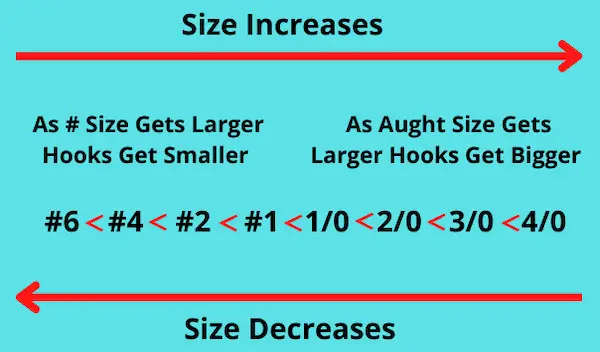
The image above shows how hook size changes on a scale of regular numbers on the left part of the diagram, and on a scale of aught numbers on the right.
This scale is a little confusing, since it actually contains two measurement scales: the ‘regular’ scale of hook sizes (on the left), and the ‘aught’ scale of hook sizes (on the right).
Let’s take a closer look at each of these in turn, to help you understand what they mean, and how they relate to each other.
‘Aught’ hook sizes
The ‘aught’ measurement system of hook sizes is written with a /0 at the end of each number (such as 1/0 or 3/0). ‘Aught’ is sometimes also spelled ‘ought’, but they both mean the same thing.
For example, a 4/0 hook is called a 4 aught hook. The aught scale starts at 1/0 (which is the smallest size), and goes up from there to larger and larger sizes.
The aught scale is used for big sizes, which are most commonly used for saltwater and offshore fishing, or for catching large freshwater fish.
‘Regular’ hook sizes
As soon as you’re dealing with a hook that’s smaller than size 1/0, its size is measured on the ‘regular’ scale of hook sizes, which is represented by a whole number with a hashtag in front of it (such as #2 or #5).
So for example, a #3 hook is called a number 3 hook. However, the confusing thing with the regular scale is that the bigger the number gets, the smaller the size of the hook becomes.
This is exactly opposite to the aught system, where increasing numbers correspond to larger hooks. Needless to say, this system is more than a little confusing for beginners, but unfortunately it is what it is.
That’s why we assembled the hook size charts above, with recommendations for different species, to make choosing the right sizes a little easier for you.
If you’re a trout angler, check out our article on what size hook should you use for trout?
What are the parts of a fishing hook?
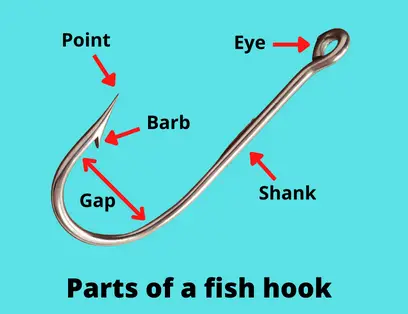
Before you buy fishing hooks, it’s helpful to get a basic knowledge of the anatomy of a fishing hook, and what its different parts look like.
So in this section, I’ll help you get an overview of the parts of a fishing hook since these terms are commonly used to describe the different fishing hook types, and you need to know them in order to choose the right ones for your purposes.
Shank
As the name implies, the hook shank is the part of the hook between the eye and the point. Most fishing hooks have a straight (or slightly curved) shank, and the length of the shank is determined by the size and type of the hook you’re using.
Eye
On a fishing hook, the eye is the round loop of metal at the top of the shank, and this is where you attach your fishing line with a knot. You can also attach a snap swivel or snap to the eye.
In most cases, the eye is completely closed, and the size of the eye correlates closely with how big the hook is. If the hook eye is larger, you can attach a heavier fishing line or snap swivel to it.
Bend
The bend of a hook is the part that curves around between the shank and the point. The shape of a bend can vary a lot depending on the type of hook you’re using (more on that below).
Gap
A fishing hook’s gap describes the distance between the point and the shank. So the wider the hook gap, the bigger the opening between its point and the shank. This distance can vary a lot between different types of hooks, and is also directly proportional to its size.
Point
The point of a hook is its sharpest part, and this is what pierces the mouth of a fish. The point is also usually the part where you thread your bait onto the hook. The shape of the point can vary depending on the style of hook that you use.
It’s essential to make sure your point is sharp, so that it will be more effective at piercing the mouth of a fish. This is especially important when targeting fish with hard, bony mouths, such as largemouth bass.
In those cases make sure to use a knife edge point, and sharpen it regularly. Also, check your point every now and then while you’re fishing, as it can become damaged or bent after getting snagged on cover, or after catching a big fish.
Barb
The barb of a fishing hook refers to the piece of metal that sticks out just below the point, which is designed to make it hard to pull it out once it penetrates the mouth of a fish. This helps to keep fish on the hook while you’re fighting them.
However, barbed hooks can also be problematic, since they also make it hard to remove the hook easily if you intend to release the fish after you catch it. Because of this, you also have the option of buying barbless hooks, which come without a barb.
Another option is to use a pair of pliers to squeeze down the barb, which in effect makes the hook barbless.
In some fisheries there are regulations that only allow you to fish with barbless fishing hooks, in order to reduce stress to the fish. This is most often the case in trout streams, in order to help protect the trout population
In summary, by changing the size and shape of the various parts of a hook, you can end up with a wide variety of hook types, and this is what we’ll cover in the next section.
Hook gauge
Hook gauge refers to the thickness of the wire with which it is made.
Thin gauge wire is advantageous when fishing with live bait, such as minnows or shiners, as it inflicts less damage on the bait fish, and is also lighter in weight, which allows the live bait to move around more actively.
Thicker gauge hooks, on the other hand, are stronger and thus better suited for fighting big and strong fish, such as catfish or salmon, since these are able to bend open a thinner gauge, which is a very annoying way to lose a good fish.
If you’re planning to catch Steelhead, take a look at our in-depth guide on the best hook size for Steelhead.
Types of fishing hooks (and how to choose the right one)
Now let’s take a look at the different types of fish hooks, and what they are used for.
J-hook
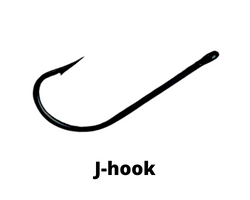
The J-hook has the most basic design of all fish hooks. It is basically shaped like a letter “J”, and comes with a medium wide gap and medium length shank.
The simple design of the J-hook makes it one of the most versatile options, and it can be used for catching almost any species of fish, while using a wide range of different tactics.
In general, it’s always good to have a set of J-hooks in the relevant size range for your purposes in your tackle box.
Bait holder hook
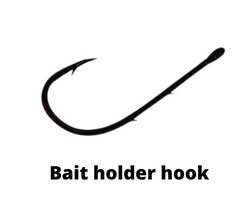
Bait holder hooks are similar to J-hooks, but come with one or two additional barbs on the shank, which are designed to keep your bait in place. This is why they’re also called bait keeper hooks, or just bait hooks.
They are great when you’re fishing with live worms or grubs, since they prevent a nightcrawler from sliding down and bunching up in a tight ball at the bend.
The main disadvantage of bait holder hooks is that they can cause quite a lot of damage to the mouth of a fish, which is problematic if you intend to release it alive.
Bait hooks are most often used for targeting small to medium sized freshwater fish with live bait or natural bait.
Octopus hook
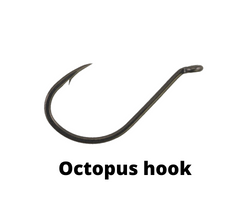
Octopus hooks are designed for small baits and finesse presentations. They are made of thin gauge metal, and come with a short shank and a relatively wide gap. This makes them ideal for fishing with natural baits and live baits.
They are most often used for targeting small to medium sized freshwater fish, including panfish, bass and trout.
Circle hook
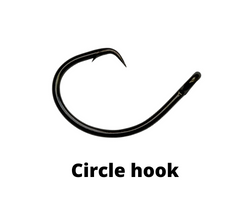
Circle hooks are designed to be fish-friendly, since their design helps to avoid deep hooks or gut hooking a fish that has completely swallowed your bait.
This is achieved by the rolled-in point, which doesn’t lodge inside the mouth of a fish until it reaches the lip. As a result, most fish are hooked in the corner of their mouth when using circle hooks.
They are often used with live bait or natural bait, and you don’t actually need to use your fishing rod to set the hook when a fish takes the bait. Instead, you just wait until the fish swims away with the bait, and then the hook sets itself.
Another advantage of circle hooks is that their rolled in point makes it very hard for the hook to be twisted out of a fish’s mouth, which thus stays in very reliably after the hook set. This makes barbless circle hooks ideal for any fisheries that only allow the use of barbless fishing hooks.
Circle hooks were originally used mostly for saltwater fishing, but have been gaining a lot in popularity with freshwater anglers for targeting larger fish, such as catfish or carp.
Treble hook
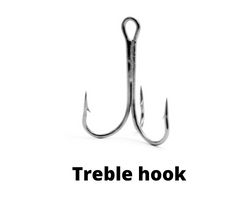
Treble hooks come with the advantage of generating more successful hook-ups, since they consist of 3 single hooks combined into one, and thus have 3 points that can lodge in the mouth of a fish.
Treble hooks are most often used on artificial lures, but can also be used as part of any fishing rig. Another advantage of treble hooks is that they are better for holding larger bait, or for holding soft or doughy bait, such ast trout Powerbait.
A disadvantage of treble hooks is that they are usually made of thicker metal, and are thus harder to embed in the mouth of a fish.
This is especially true for fish species that have a hard, bony mouth, such as bass, which explains why bass anglers like to set the hook so hard.
Worm hook
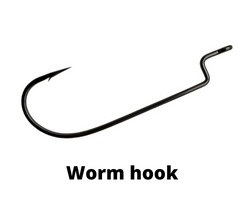
Worm hooks are designed to be used with plastic worms and other plastic baits. There is a 90 degree bend in the shank close to the eye, which is ideal for holding the tip of a plastic worm in place.
They are most commonly used with Texas rigs, as well as several other bass fishing rigs used for fishing soft plastic worms, such as the Carolina rig.
If you embed the point of a worm hook in a soft plastic bait, but without penetrating it, this makes your rig weedless, since it prevents the point from getting caught on weeds or logs.
Worm hooks are one of the most commonly used hook types for bass fishing, but can also be used for many other fish species that can be targeted with soft plastics.
Jig hook
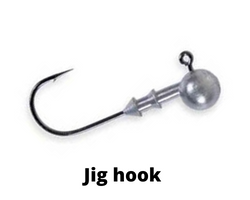
A jig hook comes with an eye that is bent at a 90 degree angle upwards. This design makes it ideal for vertical fishing.
Most jig hooks come with a weight at the eye, and are also referred to as ‘jig heads’. Jig heads are ideal for use with soft plastic baits (such as grub tails or soft swimbaits), and for fishing them vertically underneath your boat, or while ice fishing.
Aberdeen hook
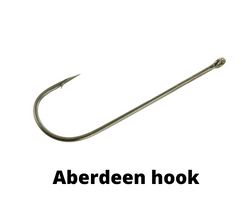
Aberdeen hooks are made of thin and light wire, and come with an extra long shank. This makes them ideal for fishing with live bait, since the thin metal inflicts less damage on the bait.
Another advantage of Aberdeen hooks is that they also cause very little damage to the fish caught with them, which is great for catch-and-release.
They are most commonly used for targeting small freshwater fish, including perch and panfish.
Kahle hook
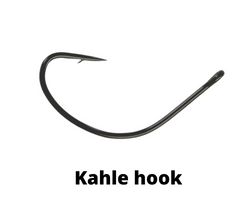
Kahle hooks are similar to circle hooks, but don’t have a rolled-in point. They are made of thick metal and come with a wide gap, and are therefore also called wide gap hooks.
Wide gap hooks are ideal for catching big fish with natural baits, and they are mostly used for saltwater fishing.
Siwash hook
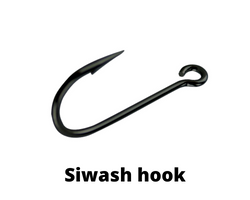
Siwash hooks are designed to replace treble hooks on artificial lures. The reason for this is that treble hooks can cause a lot of damage to fish, which is problematic if you want to release them alive.
In some trout fisheries, siwash hooks are obligatory if you want to use artificial lures, in order to improve the chances of undersized trout surviving after you release them.
They come with a large eye (which can be either open or closed) that makes it easy to put them on the rings of fishing lures.
Weighted hook
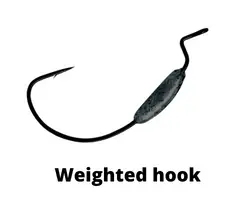
A weighted hook comes with an oval weight attached to the shank. They are either worm hooks with a weight added to them, or special swimbait hooks that come with a screw at the front used for attaching the head of the swimbait.
The location of the weight on the shank allows the soft plastic bait to sink down belly first, which looks more natural than if it sinks down head first, which would be the case if you add a sliding sinker above the hook.
Weighted hooks are most often used for fishing with worms, creature baits, or soft plastic swimbaits.
Weedless hook
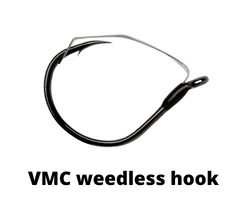
Weedless hooks come with a thin wire guard that extends from the eye to the point, which effectively protects the point from getting snagged on weeds or other obstacles in the water.
When a fish grabs the bait or lure, the pressure pushes down the wire guard, allowing the point to pierce the mouth of the fish.
Weedless hooks are essential if you’re fishing in heavy cover, and are thus a favorite of bass anglers. However, many anglers also use Texas rigging to create a weedless fishing rig, and you can also achieve this with any setup that covers the point.
Does the size of the hook matter when fishing?
Yes, the size of your hook is extremely important for improving your catch rate.
If you choose one that’s too small for the bait you want to use, then the bait won’t stay on the hook properly, and is likely to fall off when you cast it or retrieve it.
In addition, a small hook won’t perform well when you hook a big fish, such as a huge tarpon, since a strong fish can easily bend open a small hook while it’s fighting you. Ask me how I know.
Also, if you’re using a hook that’s too big for the species that you’re targeting, the hook won’t fit easily in their mouth, and is likely to spook them.
So it’s essential to choose exactly the right size hook for your fishing technique, and for the fish species that you’re targeting.
If you’re planning to target walleye, check out our article on the best hook size for walleye (for all techniques).
How do you know what size fishing hook to use?
When choosing a fishing hook size, you need to pick one that works well for both the bait that you’re going to use, as well as for the fish species that you’re planning to target.
The best way to get started with this is to check our charts above, and find the fish species that you’re planning to catch, and then use our recommended size range. For example, if you want to catch crappie, we suggest using a hook size between #12 and #4.
The best option would be to get a few sizes that cover the whole range, and then test them out on the water until you find the one that works best for you. In general, it’s best to match the hook size with the size of bait that you’re going to use.
In case you’re targeting panfish or perch, take a look at our article on what is the best hook size to use for yellow perch?
What is the smallest fishing hook?
The smallest hook size available for purchase is #32. An example of this is the Mustad 277 Gold Plated Size 32.
Tiny hooks in the range between #24 to #32 are used to tie micro dry flies, which are in turn used to target trout in small streams with fly fishing.
Needless to say, it’s very challenging to fish with these small hook sizes, and they are only used by a few fly fishermen.
What is the biggest fishing hook?
The largest fish hook size available for purchase is 27/0. An example of this would be the Mustad Giant Demon Circle Hook, which comes with a chain attached to its eye, and is used for shark fishing.
What are the best hook colors?
Hooks come in many different colors, including red, silver, orange, bronze, black, blue, gold and bronze. In order to keep things simple, you can safely ignore most of these, and just stick to black or silver hooks (which I find work for pretty much any purpose).
However, if you want to leverage hook colors to improve your catch rate, the best option is to try matching hook color to the color of your bait, which helps to avoid spooking fish that are hook shy.
What are snagging hooks, and what are they used for?
Snagging hooks are treble hooks that come with a large weight attached to their shank. They are used to catch river-run salmon by pulling a snagging hook through the water very quickly in order to snag a salmon in its side.
This technique is used as a river salmon fishing setup because salmon largely stop feeding once they migrate upstream to their spawning grounds in rivers and streams, and so often they can’t be caught with regular baits or lures at this point.
However, snagging hooks are not allowed in many waterways, and you should make sure to check your local regulations before using them.
What is an offset hook?
An offset hook is not a specific type of fishing hook, but rather refers to any situation where the point is turned out slightly with respect to the shank (as opposed to being parallel to it).
his offset helps to increase the number of successful hook sets when a fish takes the bait.
What are snelled hooks?
Snelled fishing hooks come pre-tied with a monofilament line leader, which you just need to attach to your terminal tackle with a snap or snap swivel.
Their main advantage is that their knot-to-hook connection is very strong, and they save you the time of having to tie the hooks yourself.
